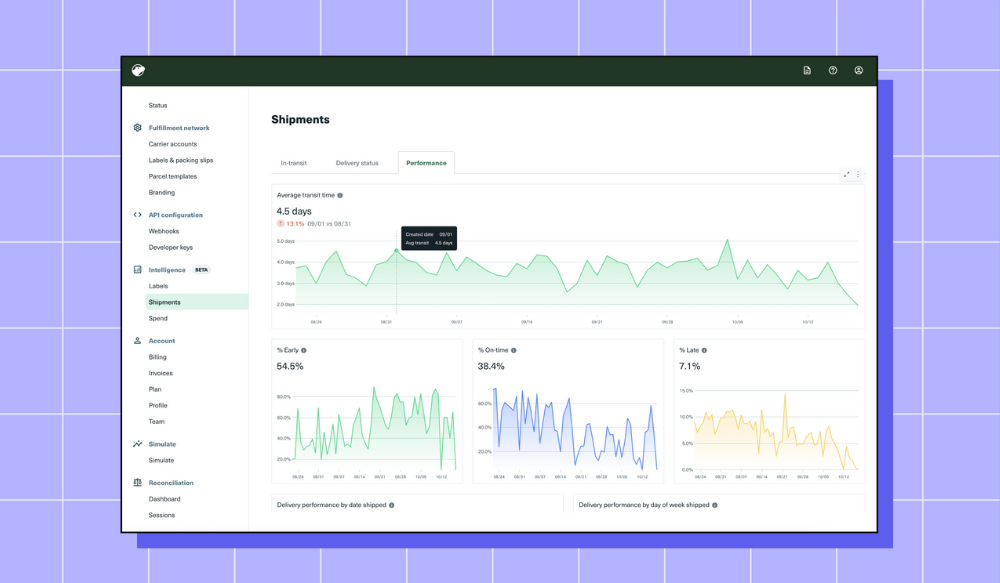How to lower e-commerce shipping costs with a shipping API
.png)
A shipping API can lower your e-commerce shipping costs by automating workflows, comparing live carrier rates, and reducing hidden fees. For scaling e-commerce brands shipping at high volumes, controlling costs isn’t optional—it’s mission critical.
Carrier rates change daily, surcharges appear without warning, and manual workflows can quickly eat into margins. The largest brands have a secret tool to solve this: a multi-carrier shipping API that connects directly to carriers, automates the most time-consuming tasks, and surfaces the data you need to make smarter, faster decisions.
Now—with tools like Shippo’s Shipping API—growing brands can access the same infrastructure without building it in-house for $800K+ and maintaining it at $300K per carrier per year.
In this guide, you’ll learn exactly how to use a shipping API to cut costs and protect margins, from live rate shopping and packaging optimization to carrier invoice reconciliation and last-mile efficiency.
1. Automate for efficiency with a shipping API
High-volume shipping magnifies mistakes. Incorrect addresses, duplicated labels, and mismatched service levels can rack up thousands in avoidable fees.
A shipping software API like Shippo’s automates core processes so your team spends less time fixing errors and more time shipping:
- Address validation to prevent delivery failures and surcharges
- Batch label creation for carrier-compliant labels without manual clicks
- Live service rate comparisons by speed, cost, and service level
- Proactive tracking with real-time updates for your customers
- Easy returns with scan-based labels or QR codes
With Shippo’s modular API endpoints, you can integrate only what you need—rates, labels, tracking, address validation—and scale from 1 label to 100K without slowdowns.
2. Compare carrier rates in real time with a shipping API
Carrier prices change constantly—sometimes daily. Locking in a single carrier means you’re likely overpaying.
A multi-carrier shipping API lets you shop live rates for every shipment, factoring in speed, cost, and service level. Instead of guessing, you can route each order to the most cost-effective option in seconds.
With Shippo’s Shipping API, your team sees these rates in your workflow—no spreadsheets, no extra tabs, no manual data entry.
3. Bring your own negotiated rates (BYOA) and apply them automatically
If you’ve negotiated carrier rates, your shipping API should apply them without manual uploads or rate card maintenance. Shippo’s API supports Bring Your Own Account (BYOA) so your contracted rates surface alongside Shippo’s pre-negotiated discounts.
That means you’re always choosing from your best available rates—without touching a spreadsheet or chasing down your carrier rep.
4. Optimize packaging with a shipping API to avoid DIM fees
For high-volume shippers, dimensional weight (DIM) fees can quietly erode margins. Choosing the wrong box size or packing material can mean paying for air instead of product.
A shipping automation API can help you model packaging choices before label creation, so you can avoid oversized boxes and excessive weight charges.
Best practices:
- Use a postage scale to weigh orders accurately
- Match box size to product size—no wasted space
- Swap to cushioned mailers when possible
- Choose lightweight, recyclable materials to cut both cost and waste
5. Audit label costs with carrier invoice reconciliation
In high-volume shipping, small discrepancies add up fast. A label quoted at $9.80 might invoice at $12.40 due to surcharges, weight adjustments, or address changes.
Shippo’s API supports carrier invoice reconciliation, comparing the quoted cost at purchase with the final carrier invoice after delivery. If there’s a mismatch, you get a clear breakdown of why—helping you dispute errors, adjust processes, and prevent repeat charges.
Learn more in How Shippo ensures accurate label costs with carrier invoice reconciliation.
6. Select the best courier for last-mile delivery
The last mile is often the most expensive part of shipping. Choosing the wrong courier can inflate costs and delay deliveries.
A shipping API uses routing logic to recommend the best courier for each shipment based on destination, delivery speed, and customer preferences. That could mean sending local orders via a regional carrier instead of a national one.
7. Use shipping analytics to refine your strategy
Your shipping API’s data is a cost-control asset. Analyzing spend by carrier, zone, and service level can reveal patterns—like a carrier consistently overcharging in a specific region or a service level that’s slower than promised.
Shippo’s API makes these insights actionable with clear, exportable reports—so you can negotiate better rates, refine fulfillment strategies, and prepare for peak seasons with precision.
Quick use-case table: How a shipping API cuts costs

FAQ: Shipping API cost-saving essentials
How does a shipping API lower costs?
It connects your store directly to carriers, fetches real-time rates, applies your negotiated or discounted rates automatically, and flags invoice discrepancies—removing costly manual steps.
When should I switch to a shipping API?
If you’re shipping at high volumes and manual tasks—like reconciling invoices, managing multiple carrier logins, or chasing down billing errors—are eating into your team’s time and margins, it’s time to upgrade.
Do I need coding skills to use Shippo’s Shipping API?
Yes—our Shipping API is designed for developers to integrate directly into your tech stack. Getting started is straightforward with our clear API documentation, SDKs, and sample code.
Glossary: Shipping API terms to know
- Shipping API – Software that connects your store to carriers, automating label creation, rate shopping, tracking, and returns.
- BYOA (Bring Your Own Account) – The ability to connect your own carrier accounts and rates to a shipping API.
- Dimensional Weight (DIM) – Pricing based on package size, not just actual weight.
- Carrier Invoice Reconciliation – Matching the quoted label cost to the final invoice to identify discrepancies.
- Last-Mile Delivery – The final leg of the shipping process, often the most expensive per mile.
Key takeaway
A shipping API is no longer just an enterprise luxury—it’s essential infrastructure for scaling e-commerce brands that want to control costs, streamline operations, and deliver a better customer experience.
With Shippo’s Shipping API, you can automate manual shipping tasks, compare rates instantly, apply your own discounts, and uncover savings hidden in your shipping data. Start with one endpoint, measure the impact, and watch your shipping costs drop.
Want to learn more? Connect with an expert.
Looking for a multi-carrier shipping platform?
With Shippo, shipping is as easy as it should be.
- Pre-built integrations into shopping carts like Magento, Shopify, Amazon, eBay, and others.
- Support for dozens of carriers including USPS, FedEx, UPS, and DHL.
- Speed through your shipping with automations, bulk label purchase, and more.
- Shipping Insurance: Insure your packages at an affordable cost.
- Shipping API for building your own shipping solution.
Stay in touch with the latest insights
Be the first to get the latest product releases, expert tips, and industry news to help you save time and money on shipping.





.png)




